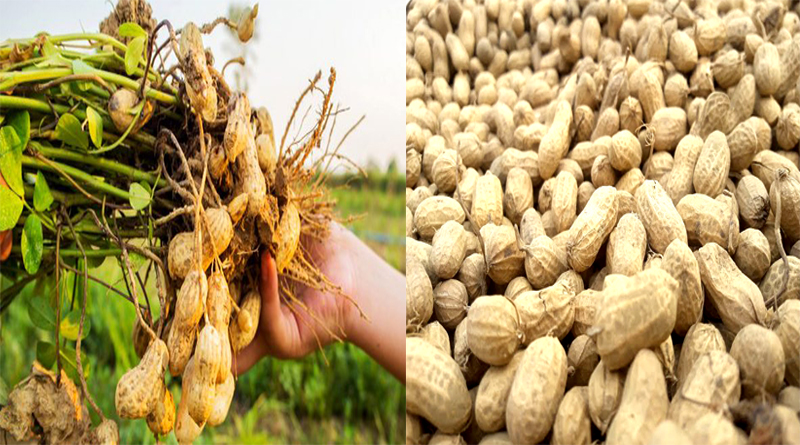How to Grow Groundnut/Groundnut cultivation method
Groundnut Farming is a very lucrative agro-business venture which guarantees a large return on investment, especially when the right practices are applied.
Because of its numerous uses, groundnuts are in great demand and this opens an opportunity for interested investors to export the product.
Do you know that Groundnut seeds contain between 48 and 50 percent of oil and 22 to 29 percent of the protein?
Uses of Groundnut
Groundnut is a popular source of food throughout the world, and for that reason, more and more people are going into this agro-business venture.
The plant is grown majorly for its nuts, oil, and its vegetative residue.
In many countries, groundnut is consumed as peanut butter or crushed and used for the production of groundnut oil or simply consumed as a confectionery snack, boiled, roasted, salted or in sweets.
Groundnuts also have a variety of industrial end uses: Paint, varnish, lubricating oil, leather dressings, furniture polish, insecticides, and nitroglycerin are made from groundnut oil.
Soap is made from saponified oil, and many cosmetics contain groundnut oil and its derivatives. The protein in groundnut is used in the manufacture of ‘ardil’, a synthetic fiber, very similar in characteristics to wool; used for sweaters, blankets, carpets, and felts.
Groundnut shells are used in the manufacture of plastic, wallboard, abrasives, fuel, cellulose (used in rayon and paper) and mucilage (glue).
Groundnut cultivation method
1. Site Selection
The groundnut pod is produced underground, thus the topsoil must have a low clay content (less than 20%) with a loose structure so that the reproductive roots may penetrate the soil freely.
Groundnut is grown in a well-drained sandy loam or sandy clay loam soil with high fertility. Optimum germination temperatures are between 20-30°C with a minimum of 18°C.
The temperature of the water absorbed by the seed is a critical factor for healthy germination. If the water temperature is initially low and gradually increases, we find reduced germination.
It is unsuitable to plant in cold wet soils. Planting in warm soils results in fast germination and healthy seedlings. Note that planting in dry soil and irrigating with cold water is not a recommended practice.
Groundnuts are adapted to a soil with a pH level between 5.5 – 7.0. At pH levels out of this range, certain elements become unavailable e.g. iron and zinc.
Being a leguminous crop, groundnuts can fix atmospheric nitrogen (N) with the aid of root bacteria thus, it does not depend on nitrogen fertilization.
Groundnuts prefer residual phosphorus (P) to freshly applied phosphorus. However, in fields where the level of phosphorus is low, it should be applied.
Like other crops, peanut plant requires sufficient levels of potassium (K) for normal growth and development. An oversupply of potassium in the soil can induce a calcium deficiency.
In situations where the soil potassium level is low, additional potassium can be applied.
2. Land Preparation
Timely field preparation facilitates timely sowing, which in turn, ensures higher yield. Land preparation should ensure that all crop residues and weeds are completely buried.
In this stage, the field is cleared, after which, plowing and harrowing are carried out to make seedbeds of fine tilth for proper germination and growth of crops.
Ploughing in summer (Just before Rainy/Planting Season) is advantageous to kill weed seeds, hibernating insects, and disease organisms, by exposing them to the heat of summer.
It is a bad idea to plant groundnut in a shallow till system of groundnut farming. This is because shallow tilling does not totally cover the plant residues present in the soil.
Where plant residues are present, pod rot diseases increase, which influence groundnut yield and quality adversely. For successful groundnut production, deep plowing should be implemented.
3. Seed quality and the handling of peanut seed
Groundnut seed is extremely susceptible to physical damage and should always be handled with care. Damaged or split kernels will not germinate and grow.
It is also important to plant high-quality seeds. Better seeds will produce more healthy groundnuts
Groundnut seed is also susceptible to fungal rot in the soil. Fungicidal seed treatment will limit this decay and increase the stand in the field.
It is therefore recommended that all seed be treated before planting.
4. Planting the Seeds
The soil should be warm at the time of planting. It is not nice to plant groundnut is very early in the morning. For better germination, it is best to let the soil warm up.
If you are using irrigation farming system to grow your groundnut, the best thing to do is to moisten the soil before planting the seeds.
By irrigating before planting the seed, you increase the growth rate of the groundnut crop.
5. Spacing
Plant your peanut seeds on a ridge or on the flat ground depending on the nature of the soil. The exact spacing distance between each peanut plant will depend on the variety of the seed you are planting.
If you are planting the variety with small seeds, the spacing should be at 50cm between rows and about 30cm between plants.
Large-seeded groundnut types are spaced at 75cm between rows and 45cm between plants. It is advisable to give good space for each planted seed to aid good yield.
6. Inter cropping and Crop Rotation
When growing groundnuts on a piece of land, inter crop it with cereals and grains. Cereals and grains help in efficient nutrient utilization and reduces soil-borne diseases.
Groundnuts are grown after crops such as; maize, small grains, sorghum, or millet.
There are difficult circumstances may force a farmer to plant groundnuts in succession, in which case, pest and disease problems become inevitable, especially leaf, and pod diseases.
Deep ploughing in circumstances like this can help control the rapid spread of disease. However, there may still be traces of disease bacterial on the farm.
At this juncture, it is important to note that Mono-culture is not a recommended practice in groundnut cultivation. Otherwise, you may suffer loss from a disease outbreak.
7. Planting Depth for groundnut
The correct planting depth of 5-7.5cm ensures that the plant develops and produces optimally. A seed which germinates slowly as a result of deep planting takes longer to emerge and a substandard plant will be produced.
Shallow planting of seed (less than 50mm) can only be considered when enough moisture is available and the climate is moist. In situations where moisture is not limiting, 50mm is the ideal planting depth.
8. Weed control in peanut farming
Weeds compete with the crop for moisture, nutrition, light, and space. Effective weed control implies good control of weed throughout the growing season.
You can control weeds by using chemicals or machines and perhaps, a combination of the two. The ultimate choice depends on the species of weeds involved, the level of infestation and the size of your budget.
Avoid piling up soil around the main stem of the groundnut plant. This practice is an important yield-limiting factor. It influences pod formation of the lower highly productive nodes and promotes disease development.
9. Harvesting
It takes only about three months for groundnut to mature. Harvesting usually consists of a series of operations comprising digging, lifting, windowing, stocking, and threshing.
Some of this harvesting operation can be combined or eliminated totally, depending on the harvesting system you are using.
Make sure the peanut plant has reached maturity from your observation before you even think of harvesting the crop.
You can know when your groundnut plant has reached maturity by observing the leaves. When you start seeing yellow spots spread across the growing peanut plant, that is a good sign that your groundnut is ready for harvesting.
Another, and even more efficient, way of knowing is your groundnut is ready for harvesting is by checking the pods of the plant.
To do this, harvest random samples of the plant and cut out some groundnut pods from the root.
Break the groundnut open to see inside the pod. The peanuts should nearly fill the pods.
Also, If the interior of the pod is dark in color, it means that the peanuts are over mature for boiling but are still good for dry roasting.
You must ensure that you harvest the groundnut before it passes the stage of full maturity, otherwise, an appreciable number of pods could be lost.
To harvest your groundnut, pull out the plant from the soil and shake off the excess soil attached to the root, leaving the pods attached.
10. Processing Peanuts into other products
A lot of machines are available for processing groundnuts, including; groundnut sheller, and groundnut oil expeller. With these two machines, you can successfully process large quantities of groundnuts into the oil.





I like this site it’s a master piece! Glad I discovered this
ohttps://69v.topn google.Raise your business